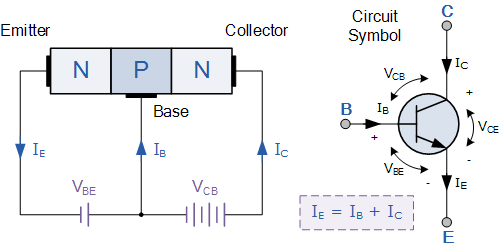

The magic in a transistor is determining how to get the amount of current you want flowing through the collector. If the emitter is at +2 V, then you must bring the base to about 2.7 V to get current to flow from the collector to the emitter. If the collector is at +5 V and the emitter is at ground, bringing the base to about 0.7 V will cause current to flow from the 5 V supply-through the collector-to the emitter and to ground. It’s why the actual transistor differs from the diode model, and it’s why you can’t build a transistor from two diodes. The collector-emitter current flow is inherent in the construction of the transistor. If the base-emitter voltage is below 0.7 V, the transistor is in “cutoff” and no current flows through the emitter or through the collector. If the collector is connected to +5 V and the emitter to ground, and the voltage on the base is high enough (0.7 V) to forward-bias the base-emitter junction, current will flow from the base to the emitter and from the collector to the emitter. Now discard the diode model and look at a real transistor. The collector diode will be reverse-biased, and no current will flow through that diode. If you apply a positive voltage greater than 0.7 V to the base, the emitter diode will be forward-biased and current will flow from the base, through the emitter and to ground.

The junction of the two anodes represents the base of a transistor. Referring to the diode model, if you connect the collector to a positive voltage-say 5 V-and the emitter to ground, you end up with two diodes back-to-back with their anodes connected together. Operation of an NPN transistor is conceptually easy to understand. You can’t build a transistor out of two diodes, but using two diodes helps to explain how the transistor biasing works.įIGURE 1 – Schematic symbol, physical representation and diode model of NPN transistor The diode representation of the transistor indicates how current flows, not how the actual part is constructed. In an actual transistor, the collector region is normally larger than the emitter region, and none of them is square as shown in the diagram.

The N-P-N structure is just representative. An NPN transistor has a P-type layer sandwiched between two N-type layers, and a PNP is the reverse.įigure 1 shows an NPN BJT schematic symbol, a simple diagram of the structure, and a diode model. The silicon is modified (doped) with impurities to produce N-type or P-type material. In this article, I want to go over some very basic things about transistors, how they are used and how you can include them in your applications.Ī BJT (bipolar junction transistor) was the first commonly available transistor, and it fueled the transition away from vacuum tubes. Electronics manufacturers and distributors still make and sell individual transistors because the parts still have some uses. Transistors, for example, typically have much higher operating voltage and power limits in simple circuits than those of comparable ICs. A discrete transistor can be a simple way to solve some problems. It would not be possible to build a modern microprocessor with discrete transistors-the lead lengths alone would make the speeds impossible. It’s true that nearly all the things we used to do with transistors can be done cheaper, better and more efficiently with an IC, and we can do things with ICs that are not possible with discrete transistors. But isn’t a single transistor obsolete as a circuit element today? What use does a lowly transistor have in a world where the current Intel microprocessors have over a billion transistors each? Before the IC and microprocessor revolutions, there was a transistor revolution-where televisions, radios and computers were built using the new solid-state devices.
#Transistor saturation full#
What good is a transistor? Sure, integrated circuits (ICs) are full of transistors, thousands of them.

In this article, Stuart reviews some important basics about transistors and how you can use them in your embedded system design. But electronic component vendors do still make and sell individual transistors because there’s still a market for them. And Their Role Today In this day and age of highly integrated chips, what is the relevance of the lone, discrete transistor? It’s true that most embedded system design needs can be met by chip-level solutions.


 0 kommentar(er)
0 kommentar(er)
